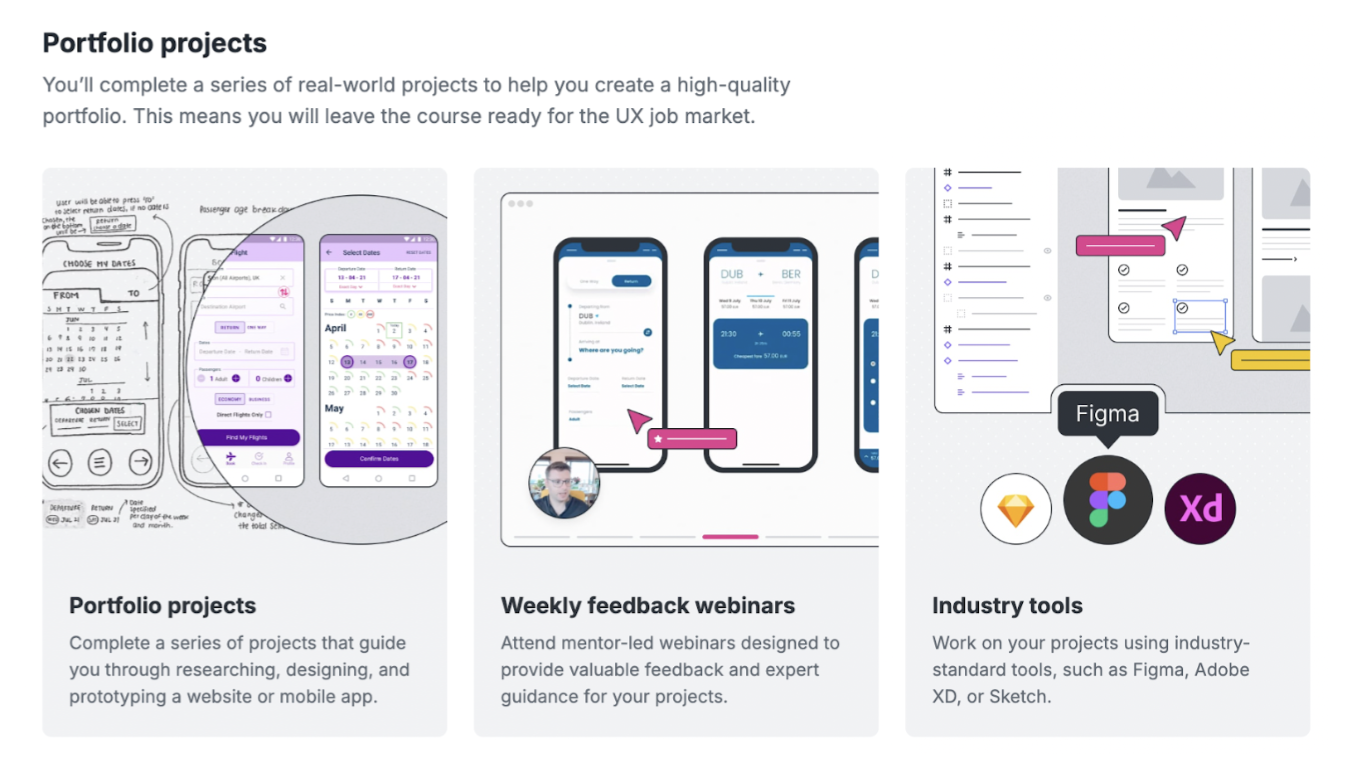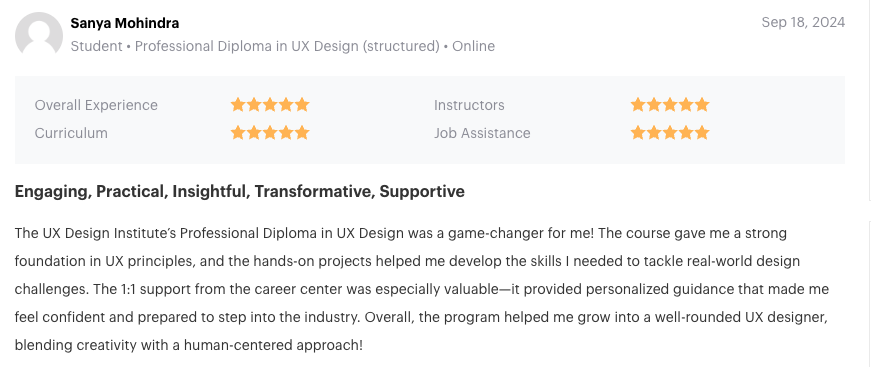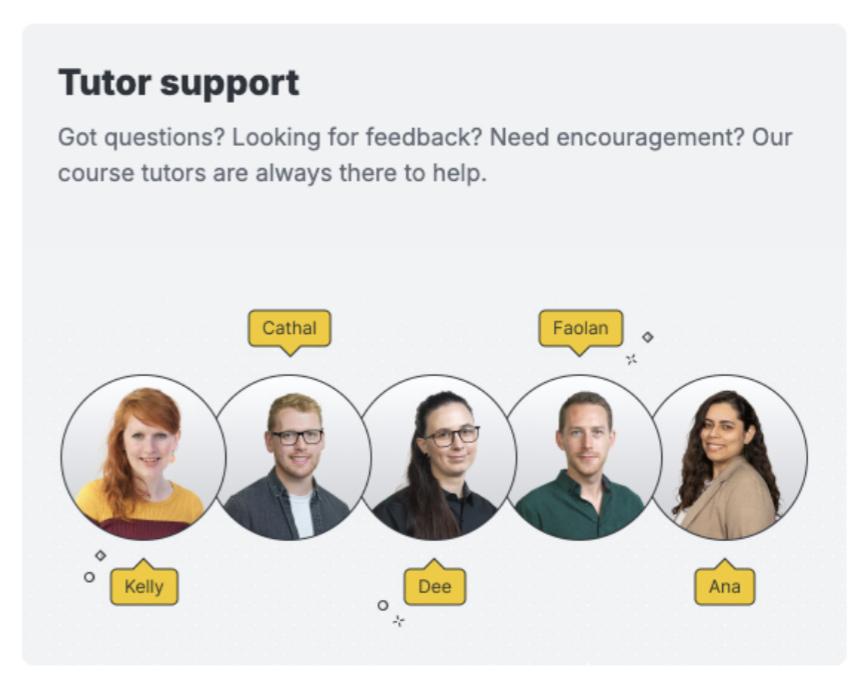If you’re thinking about taking a UX design course, you must do your research first. Before you sign up, you want to be sure that you’re investing your time and money wisely.
One of the best ways to vet a particular course (or course provider) is to hear from past students.
Genuine reviews and testimonials give you valuable insight into what it’s like to study with a certain provider. They also allow you to gauge how effective the course is for different people with varying professional backgrounds.
If the UX Design Institute is on your shortlist, then this article is for you. We’ve compiled some of our most recent student reviews, together with some additional green flags to look out for when choosing a UX course.
Did we mention that Course Report chose us as one of the 14 top design schools for UX that they would recommend to their family and friends in 2024 on the strength of student feedback? There are plenty of reasons for that recommendation, let’s dig into a few.
Why study UX design with the UX Design Institute? (With student reviews)
The Professional Diploma in UX Design provides a thorough and up-to-date education in UX. It balances independent learning with expert human support and combines solid theory with hands-on project work.
Here are the main reasons our students choose to study with us, together with real reviews and testimonials from our recent graduates.
1. A qualification recognised by employers everywhere
The Professional Diploma in UX Design, like all our courses, is credit-rated by Glasgow Caledonian University, giving our graduates a reputable certification that employers recognise and trust. This is what our graduate Denis Mollaymeri who works as a UX/UI Designer at Cardo AI has to say about the course,
The industry recognition associated with the course certification has been invaluable. Employers highly regard the credential from the UX Design Institute, enhancing my credibility and marketability in the field.
The university credit rating enables our graduates to verify their skills, stand out in the job market, and position themselves as qualified UX candidates with a genuine education. Another diploma graduate, Kim Noel who landed the role of UI/UX Designer at MindCanvas shares,
Completing a UX Design Institute course, recognised by industry leaders and accredited by a reputable university, has boosted my professional credibility, opening doors to job interviews and career advancements I might not have accessed otherwise.
With so many UX courses and qualifications available nowadays, a university credit-rating serves as a major differentiator.
For many students, this provides an additional marker of credibility and trust when choosing a UX course—and, when it comes to applying for jobs, a distinct advantage with employers. Keelan Vella, Product Lead at Buddy sums it up nicely,
What really stood out to me was that the course is credit-rated by Glasgow Caledonian University. This distinguishes the Institute from the numerous non-rated programs available in the competitive job market of today, when the majority of hiring managers give priority to credit-rated courses. The combination of accreditation and their ongoing industry engagement makes the UX Design Institute both a standard and an invaluable resource for staying current in the field.
2. High job success rate upon completion of the course
Thousands of UX Design Institute graduates have been hired by great companies after completing the UX design course. In fact, 79% of graduates from our Professional Diploma in UX Design get jobs in the UX industry within six months of completing the course.
Our recent graduate, Luke Bracken landed a UX Design role with IBM. Here’s what he has to say,
The knowledge I gained combined with the portfolio project I created was the perfect combination for me to take the next step in my career. I have no doubt it helped me land my role as a UX Designer at IBM and I accredit most of that to the portfolio project as that is what shows your potential employer your skills and experience in action.
Another student, Nada landed an internship while still taking the course—and went on to be hired for a full-time role just four months later:
| “I was interviewed and hired as an intern in a tech company a few months after starting the course. I was asked about what I had learnt so far and what else was left for me to learn in the course. 4 months later, I was hired as a UX/UI designer.”
-Nada Elmallah, UX/UI Designer at Brightskies |
Annie Crossland is yet another student who got hired as a Product Designer at Cirevo before finishing the UX course:
I secured a Product Designer position at the startup Cirevo even before completing my UX Diploma. They were intrigued by my commitment to continuing studies and skill development.
Many of our students have also been able to secure promotions and advance in their careers as a result of their new skills. Keelan, for example, got promoted to Product Lead after completing the UX course:
| “Having come from a background in software development, this diploma was invaluable to me in developing my profession. It fundamentally shifted my perspective, helping me understand that it’s not about adding more features, but about designing the right features specifically tailored for the users.
-Keelan Vella, Product Lead at Buddy |
Keelan further adds,
Without the knowledge and insights I acquired from the UX Design Institute, I might not have been given the opportunity to ascend to the position of Product Lead. This training has been invaluable to me both professionally and in the software development industry.
3. Expert mentor feedback throughout the course
Our students learn flexibly and independently, but never alone. With multiple live, mentor-led workshops every week, expert feedback is built right into the learning experience.
For former student Denis, this ongoing support was fundamental to his success on the course:
| “The supportive community and access to experienced mentors enhanced my understanding and made the learning journey more fulfilling. Overall, the course’s blend of theoretical knowledge and practical application, coupled with a supportive learning environment, made it a truly enjoyable and enriching experience.”
Denis Mollaymeri, UX/UI Designer at CARDO AI |
All UX Design Institute mentors are highly experienced UX professionals with a genuine passion for design—and for empowering others to succeed in their UX careers.
| “The mentor-led webinars, which were dedicated to discussing and reviewing our projects, were extremely helpful. They provided detailed feedback and clarified any questions or concerns I had about the assignments, ensuring I felt supported throughout the course. Overall, the combination of a well-organised curriculum and effective project support made the learning experience both engaging and rewarding.”
– Natalia Porys, former architect transitioning to UX |
4. An in-depth, industry-relevant curriculum
The course curriculum covers everything you need to confidently work as a UX designer. It spans the entire UX design process end to end, from user research and analysis, right through to prototyping and handover. Read what our student Ryan Stephenson, Graphic Designer at DeMontfort Fine Art has to say,
| “I recently completed my Professional Diploma in UX Design with the UX Design Institute and am thrilled with the results. The course was comprehensive, significantly broadening my understanding and skills in the field. The hands-on projects pushed my capabilities, and I was pleasantly surprised by the quality of work I produced and my growth as a designer.” |
Happy with the outcome of the course, Ryan adds,
Overall, the course exceeded my expectations. It provided me with the technical skills and confidence to excel in UX design. I highly recommend this program to anyone looking to advance their career in UX design.
Students learn the most relevant industry tools such as Figma, Adobe XD, and Sketch. The curriculum also includes a brand new module covering the role of AI in UX design.
And, because the curriculum has been carefully structured to cover all key topics in the most logical order, progression from one module to the next feels easy and intuitive. You’ll build your knowledge incrementally, learning through accessible and digestible content without compromising on depth and breadth.
| “The course structure was a major highlight. Each module addressed a different aspect of UX. The information in each module was well-balanced—neither too much nor too little—which made the content easy to follow and prevented me from feeling overwhelmed.”
-Natalia Porys, former architect transitioning to UX |
The course content is regularly updated to ensure that it’s in line with current industry standards, trends, and employer needs. This keeps our students at the cutting-edge and ensures they’re ready for the job market.
The quality of the curriculum, and the overall learning experience, is something our students often mention as a major highlight. For a course that specialises in UX Design, there can’t be a better complement than the one from Michèle de Villiers, former architect turned UX designer,
UX Design Institute goes the extra mile! The design of the course itself is a masterclass in user experience. The content is very informative, and the structure of the course around a design project is essential for developing a key piece in your portfolio. The support from the team is fantastic, and the ability to finish it in your own time over the course of a year is so convenient.
5. Hands-on learning with practical portfolio projects
The curriculum combines essential theory and practical work, including real-world projects to actively apply what you’ve learned.
In a highly practical field like UX, this kind of hands-on learning is crucial. Our students graduate with the confidence to enter the job market—and they have a professional UX portfolio to house their projects and showcase their skills in action.
For many of our students, this practical element sets the diploma apart from other, more theory-heavy courses on the market. Hear from Kim Noel, UI/UX Designer at MindCanvas,
What I enjoyed most about the course was the perfect blend of theoretical knowledge and practical application. The course provided me with a deep understanding of UX design principles, methodologies, and best practices which formed a strong foundation for my career. However, what truly stood out was the opportunity to apply this knowledge immediately through hands-on projects.
Kim further adds how this hands-on approach helps to nurture a UX mindset,
| “The practical assignments allowed me to work on real-world design challenges, enabling me to see the direct impact of UX decisions on user experiences. It was incredibly rewarding to see my skills evolve as I progressed through the course, and to receive constructive feedback from experienced instructors and mentors.” |
Former student Melvin Chinedu Ogbalu, a User Experience Design Consultant at Accenture explains how the practical nature of the course helped to reinforce key concepts and accelerate their learning experience:
What I enjoyed most about the course was the perfect balance between theory and hands-on experience. The curriculum not only provided a solid foundation in UX design principles, but also allowed me to apply them to real-world projects. The interactive nature of the course, with practical exercises and engaging projects, made the learning experience dynamic and enjoyable.
This type of hands-on learning is not only highly effective. It’s also much more enjoyable and engaging, allowing our students to have fun while they learn.
6. Career guidance, tutor support, and a strong community
The course itself is just one aspect of the entire UX Design Institute experience. Beyond the core curriculum, students receive personal support from education advisors and course tutors.
They’re also connected to a thriving community of fellow students and have ongoing access to industry experts through regular webinars. Despite the fact that the course is delivered online and that students can learn at their own pace, the community is only ever a few clicks away.
As many of our graduates point out, this creates a highly rewarding and supportive environment:
| “It is hard to balance a full time role with education and a social life! So I loved being able to take in the lectures at my own pace and even revisiting them before my exam
-Luke Bracken, UX Designer at IBM |
Luke, who landed a role with IBM shortly after graduating from the UX design diploma, also appreciates the support of the community,
I also loved the support from the UX Design Institute team and the Slack community. Having access to the career sessions afterward to go through my portfolio was really helpful.
Even after completing the course, students can continue to access our expert-led webinars—encouraging ongoing learning and industry engagement.
| “I thought the course provided a really good grounding in UX to build upon. The learning set-up meant I had the flexibility to complete the diploma in my own time whilst balancing work and family. I’ve really appreciated the webinars with industry experts they run most months (that I will have continued access to) and I felt that the support and feedback from tutors was a key selling point that didn’t disappoint.”
-UX Design Institute graduate via Trustpilot, June 2024 |
No matter how good the course curriculum is, students can only get so far by themselves. That’s why it’s so important to provide regular support and feedback—something that former student Ryan Stephenson, Graphic Designer at DeMontfort Fine Art, found particularly valuable:
The support from the UX Design Institute team was outstanding. The staff was incredibly helpful and responsive, providing thorough and constructive feedback. The online platform made it easy to get the support I needed at any time.
Overall, the Professional Diploma in UX Design by the UX Design Institute gets a big thumbs up from our students and graduates who see its strong value and transformative power to steer careers. Here’s a review from a happy student on Course Report (yes, the same good folks who rated us among the 14 top design schools of 2024!):
Green flags to look out for when choosing a UX design course
Student testimonials provide great insight into the quality and effectiveness of a particular UX course and/or course provider. Besides positive reviews, here are some additional green flags to look out for when choosing a course.
Experienced instructors with legitimate credentials
The best providers will proudly display their course mentors and tutors on their websites. Look for courses that have a strong team of UX experts on board; experts who have significant experience in the industry and are truly qualified to teach UX. Plus, there should be a team of tutors to help you with your day-to-day coursework, queries and assignments.
Source: uxdesigninstitute.com
Human support throughout
When exploring different course providers, it should be easy to reach out to an advisor who can tell you more about the course. Look out for quick response times and informative support, rather than pushy sales tactics.
| “UX Design Institute practises what they preach. Really professional with exactly the right people giving you exactly the right advice at exactly the right time. The course design has been a living example of great UX.”
-UX Design Institute graduate via Trustpilot, August 2024 |
A university credit rating
Courses that are university credit-rated must be regularly vetted and approved by an external body. If a course provider has an up-to-date university credit rating, that’s a great indicator of quality and relevance.
An industry-relevant, up-to-date curriculum
UX design is a fast-moving field, and lots has changed in recent years—especially with the advent of AI. Check that the course content is relevant and up-to-date. If the curriculum includes up-to-the-minute topics such as the role of AI in UX design, that’s a positive sign.
Practical projects
UX design is an extremely hands-on industry, and employers will want to see evidence of your practical skills. A top-quality course will combine theory and practical work, having you apply what you’re learning to real projects and exercises.

A good balance between flexibility and accountability
The course schedule needs to be realistic and manageable, so look for providers that balance flexibility (i.e. self-paced learning) with accountability (i.e. regular deadlines and milestones).
Transparent pricing
The cost of the course should be displayed upfront on the provider’s website—there shouldn’t be any ambiguity around how much you’ll need to pay.
Next steps
If you’re ready to sign up for a UX design course or want to learn more about the UX Design Institute, visit the Professional Diploma in UX Design official course page. Here you can request a more detailed breakdown of the syllabus and book a call with an education advisor. They’ll answer any questions you might have about the course, and help you figure out if it’s the right option for you.
Exploring the UX design industry and weighing up your options? Check out these guides for further advice and insights:
- Is the UX job market oversaturated? An in-depth analysis and outlook for 2024
- What does it take to land a job in UX? Top insights from the UX Design Institute’s State of Hiring Report 2024
- Want to start a career in UX? Bootcamps and free courses may not be the answer










